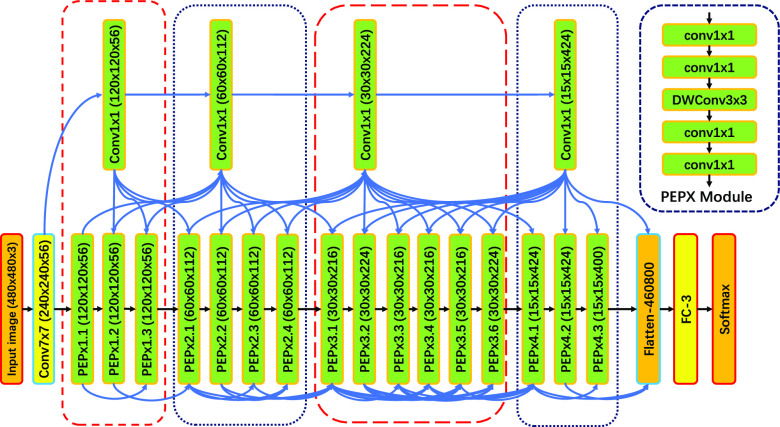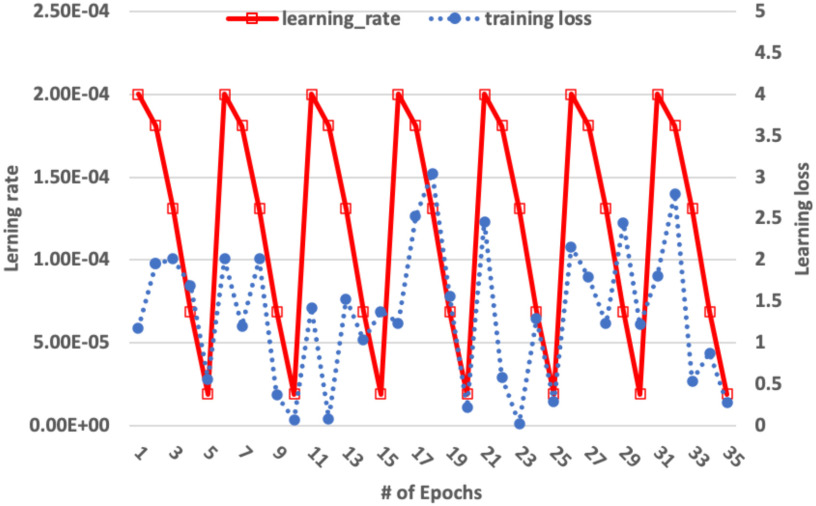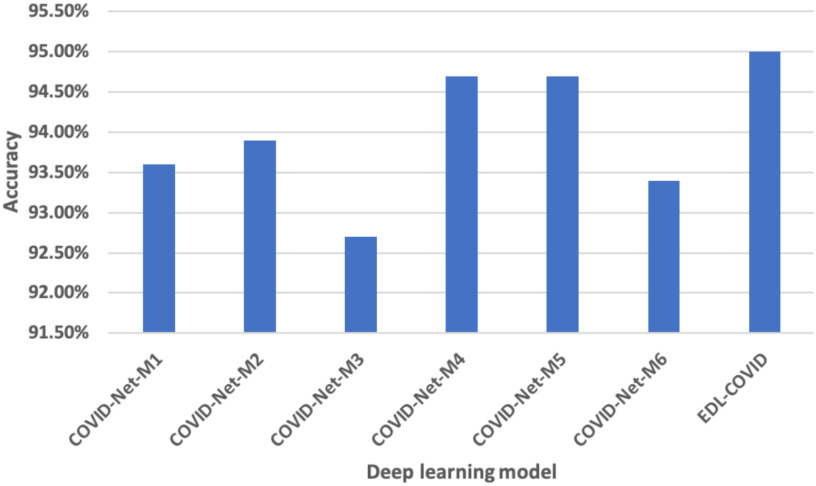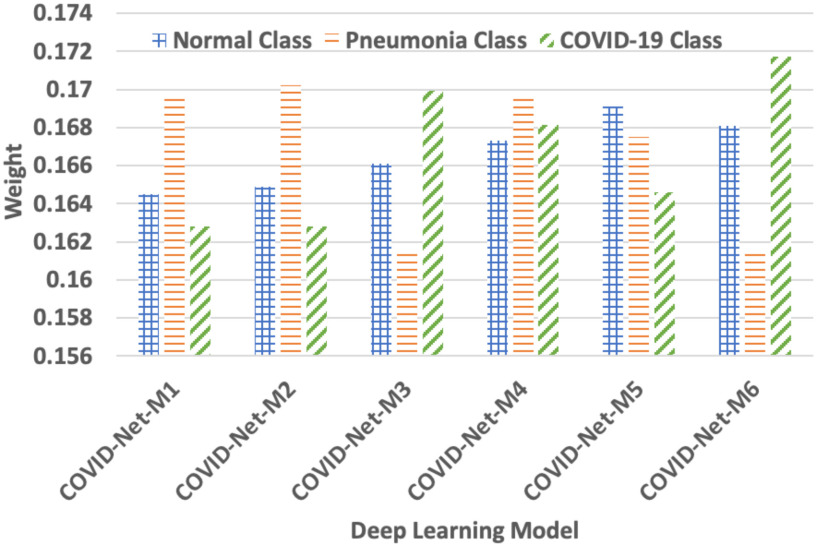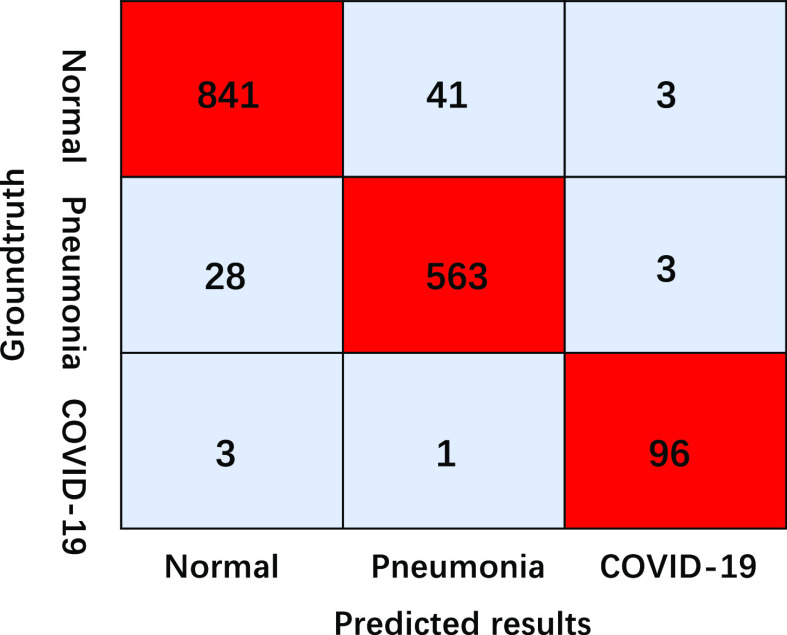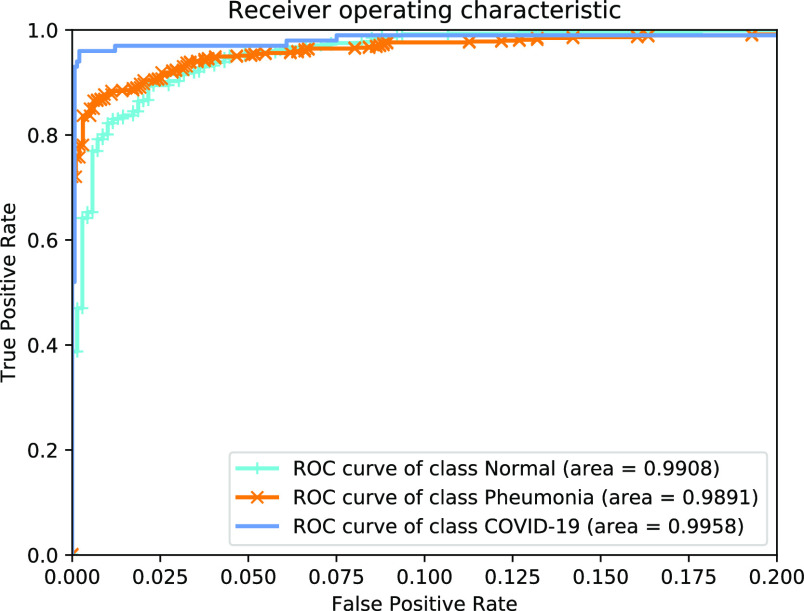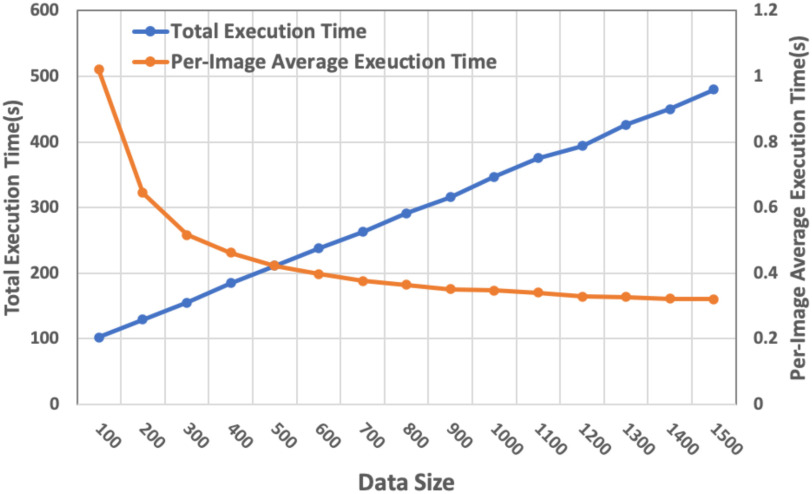Abstract
Effective screening of COVID-19 cases has been becoming extremely important to mitigate and stop the quick spread of the disease during the current period of COVID-19 pandemic worldwide. In this article, we consider radiology examination of using chest X-ray images, which is among the effective screening approaches for COVID-19 case detection. Given deep learning is an effective tool and framework for image analysis, there have been lots of studies for COVID-19 case detection by training deep learning models with X-ray images. Although some of them report good prediction results, their proposed deep learning models might suffer from overfitting, high variance, and generalization errors caused by noise and a limited number of datasets. Considering ensemble learning can overcome the shortcomings of deep learning by making predictions with multiple models instead of a single model, we propose EDL-COVID, an ensemble deep learning model employing deep learning and ensemble learning. The EDL-COVID model is generated by combining multiple snapshot models of COVID-Net, which has pioneered in an open-sourced COVID-19 case detection method with deep neural network processed chest X-ray images, by employing a proposed weighted averaging ensembling method that is aware of different sensitivities of deep learning models on different classes types. Experimental results show that EDL-COVID offers promising results for COVID-19 case detection with an accuracy of 95%, better than COVID-Net of 93.3%.
Keywords: Covid-19, chest X-ray images, deep learning, EDL-COVID, ensemble learning
I. Introduction
The novel Coronavirus Disease 2019 (COVID-19), as an unprecedented infectious and dangerous disease around the world, is caused by SARS-CoV-2, a severe acute respiratory syndrome coronavirus 2, which has not been ever found in humans before Dec 2019 [1]. There is a rapid person-to-person coronavirus transmission between two people in close contact via aerosols or small droplets created by talking, coughing, and sneezing. Once infected, people tend to have the following common symptoms after several days, including fever, cough, taste/small loss, and shortness of breath. As of  January 2020, there are still more than 90 million active infected cases, and 1.94 million people have died worldwide.
January 2020, there are still more than 90 million active infected cases, and 1.94 million people have died worldwide.
To stop the fast spread of COVID-19, an important task is to find out infected people via effective screening such that they can be isolated and received immediate treatment. So far, the most commonly used screening approach for COVID-19 case detection is to take a reverse transcription polymerase chain reaction (RT-PCR) test over a sample of nasopharyngeal exudate collected from suspectable people for the qualitative detection of nucleic acid from SARS-CoV-2 attributes to its merits as a simple but specific qualitative assay [6], [30]. Although RT-PCR testing has been recognized as a “gold standard” for infected case discovery of the disease, there are still several issues about it. First, the sensitivity of its detection results is highly variable, which can generate false-negative and false-positive results according to a recent study by Tahamtan et al. [34]. Second, due to the quick spread of COVID-19, there are not sufficient PCR reagent kits to satisfy the overwhelming screening demand especially in poor and heavily affected areas [35].
In addition to RT-PCR, radiography examination is an alternative effective screening method for fast detection of COVID-19, where the chest X-ray (CXR) and CT images are performed and analyzed by radiologists to judge whether a suspectable person has been infected or not by SARS-CoV-2 [3], [36]. Recent studies have observed the abnormal features in radiography images of COVID-19 cases and it has been widely used in China at the earlier stage of the global outbreak [15], [16], [38]. Although CT scan has a higher sensitivity to pulmonary diseases, there are several limitations for its practical uses in COVID-19 case detection at a larger scale, including nonportability, long-time scanning, and the risk of exposing the hospital staff. In comparison to CT scans, CXR imaging is portable, faster, more readily available, and can be performed within an isolated room while offering an acceptable accuracy in COVID-19 case detection [29]. Due to these benefits, many recent studies [7], [18], [29], [36] have now focused on CXR image analysis for COVID-19 case detection. Particularly, there are some studies [25] suggesting to take portable CXR imaging as a reliance method for COVID-19 case detection with the quick spread of the pandemic.
While CXR imaging is very fast, it needs expert radiologists to make judgment for COVID-19 case detection manually, which requires professional knowledge and is a time-consuming process. Meanwhile, the number of radiologists is much fewer than that of people under detection. An artificial intelligence (AI)-aided diagnostic system is thus needed to assist radiologists to make screening of COVID-19 cases in a more rapid and accurate way, otherwise it is prone to occur that infected people cannot be detected and quarantined as soon as possible and in turn cannot receive treatment timely [24], [36].
Essentially, COVID-19 case detection with CXR images is a classification problem in the machine learning domain, for which convolutional neural network (CNNs) enabled data-driven deep learning methods have demonstrated promising performance [21]. As such, many recent studies [6], [24], [26], [36], are available for attempting to train new deep learning models for infected case detection with CXR images by either reusing or modifying existing deep neural networks atop of collected CXR images datasets. However, due to the noise and limited training data size in practice, a deep learning model might suffer from overfitting, high variance, and generalization errors although some studies in their articles report much high prediction accuracy for their proposed deep learning models with their own datasets.
To alleviate it, instead of using a single model, ensemble learning that combines multiple models together with a proper strategy (e.g., random forest [10], boosting [32], stacking [12]) is assumed to be an effective technique. It is able to not only reduce the variance and generalization errors of predictions but also can yield a better result than any single model [28].
In this article, to take advantage of both deep learning and ensemble learning, we propose EDL-COVID, an ensemble deep learning model for detecting COVID-19 cases with CXR images. There are several challenging issues for ensemble deep learning model development. First, it needs to have multiple deep learning models for combination, whereas training a deep model generally takes a significant amount of computational cost and a long time to converge. Moreover, the development of a good ensemble deep learning model depends on both the accuracy of each individual model and the diversity among these deep learning models [13].
To reduce the computation cost as well as training time, instead of training multiple different deep neural networks, we consider an alternative approach of generating multiple deep learning models using a single deep neural networks. Specifically, we execute a single training run with multiple model snapshots first, and then ensemble the prediction results for a final prediction. However, there is a big problem with this approach that the produced multiple models can be quite similar to each other since they have the same network architecture as well as training initialization, violating the model diversity requirement of ensemble learning. Using these similar models tends to result in similar predictions and prediction errors, indicating that the combination of these models cannot offer much benefit. To resolve it, one effective approach is to make an aggressive learning rate change during a single neural network training process, which can force the exploration of different model weights and produce a diversity of multiple snapshot models [22].
Specifically, our proposed EDL-COVID is based on COVID-Net [36], which is state-of-the-art open-sourced deep CNN for COVID-19 case detection from CXR images. By using COVID-Net network architecture as well as its datasets of COVIDx [2], we first train multiple snapshot deep learning models with a cosine annealing learning rate schedule, for which the learning rate fluctuates significantly in that it starts high and drops to a minimum value close to zero rapidly before going up to the maximum value again [22]. Next, the ensemble deep learning model of EDL-COVID is developed by combining these models with a proposed model ensembling approach called weighted averaging ensembling (WAE), which is based on two observations that 1) there are different sensitivities for different classes types of an individual deep learning model, and 2) different deep learning models have different sensitivities for each class type. WAE is based on the assumption that for a class type, a model with a higher sensitivity should contribute more to the final ensembling result by estimating its weight proportional to its sensitivity. Finally, the experimental results show that EDL-COVID achieves promising results for case detection from CXR images with 95.0% accuracy, 96.0% sensitivity, and 94.1% PPV for the COVID-19 class type.
In summary, the following contributions are made in this article.
-
1)
We propose a weighted average ensembling (WAE) ensembling strategy with the awareness of varied class-level accuracies for different machine learning models.
-
2)
We propose a snapshot ensemble deep learning model called EDL-COVID based on the state-of-the-art deep learning architecture of COVID-Net.
-
3)
We evaluate EDL-COVID experimentally, showing the promising results of EDL-COVID.
The rest of this article is organized as follows. Section II provides a background of ensemble deep learning and COVID-Net. In Section III, related work is reviewed. The proposed EDL-COVID model is introduced in Section IV. Experimental evaluation of the proposed model is provided in Section V. Finally, Section VI concludes the article.
II. Background
For the sake of better understanding the EDL-COVID model, we give a description of ensemble deep learning and COVID-Net network that EDL-COVID is built on for COVID-19 case detection.
A. Ensemble Deep Learning
As a powerful machine learning technique, deep learning is widely applied to many studies, e.g., computer vision, speech recognition, medical image analysis, drug design, etc [8], [23]. It contains a multilayer neural network that can progressively extract higher level features from raw data such as images and produce prediction outputs based on those features. A deep learning model computation consists of two stages, namely training and inference. Training is an iterative and stochastic computation for generating a model based on training data. Several arguments need to be initialized before training computation, including learning rate, epoch number, and batch size, where different configurations tend to result in models with different accuracies. Inference is a prediction process with the trained deep learning model. Some popular deep learning architectures are available, e.g., CNN and recurrent neural networks (RNN). In comparison, CNN is the most popular one, which is good for applications such as image detection/recognition, image classification, and medical image analysis [5].
With the existence of the noise in the training data and the randomness in the deep learning algorithm, however, it tends to suffer from high variance problem and generalization error [19]. Although there are some commonly used techniques such as data augmentation and regularization [9], the problems are still not well addressed for deep learning models.
To overcome these problems for a single machine learning model, ensemble learning is assumed to be an effective approach [28]. It is a hybrid learning paradigm that is able to produce more accurate and robust prediction results than a single model by combining multiple machine learning models intelligently. Various ensemble strategies are available, including averaging, random forest [10], boosting [32], and stacking [12]. To make the ensemble effective, we must make sure that multiple models for combination is diverse. In the proposed work, we study ensemble deep learning for COVID-19 case detection by combining multiple deep learning models via an ensemble strategy.
B. Covid-Net
COVID-Net [36] is by far the state-of-the-art deep convolution neural network for CXR image processing based COVID-19 case detection.1
Fig. 1 presents its network architecture, which is a carefully designed model for COVID-19 case detection in a human-machine collaborative manner with the following characteristics. First, it exploits a design pattern of lightweight residual projection-expansion-projection-extension (PEPX) heavily, which makes up of first-stage projection, expansion, depth-wise representation, second-stage projection, and extension. Specifically, the First-Stage Projection is a  convolution to project input features from a high dimension to a lower one. Expansion is a reverse procedure that expands features to a higher dimension with a
convolution to project input features from a high dimension to a lower one. Expansion is a reverse procedure that expands features to a higher dimension with a  convolution. Dep-wise Representation is responsible for learning spatial features to minimize computational complexity while keeping representational capacity via a
convolution. Dep-wise Representation is responsible for learning spatial features to minimize computational complexity while keeping representational capacity via a  depth-wise convolutions. Second-stage Projection projects features back to a lower dimension with a
depth-wise convolutions. Second-stage Projection projects features back to a lower dimension with a  convolutions. Finally, Extension extends channel dimensionality to a higher one to produce the final features with
convolutions. Finally, Extension extends channel dimensionality to a higher one to produce the final features with  convolutions. Second, it contains long-range connectivities at different places of the network architecture. Third, the COVID-Net network is considerably diverse in order to realize a strong representational capacity for COVID-19 case detection. All of these features enable COVID-Net to achieve a strong representational capacity while keeping computational complexity reduced. It offers a COVIDx dataset for training, which classifies people into the following cases, i.e., normal, pneumonia, as well as COVID-19 as Fig. 2 shows. By using the COVIDx dataset [2], it is reported for COVID-Net that it can achieve an accuracy of 93.3%, and positive predictive value (PPV) of
convolutions. Second, it contains long-range connectivities at different places of the network architecture. Third, the COVID-Net network is considerably diverse in order to realize a strong representational capacity for COVID-19 case detection. All of these features enable COVID-Net to achieve a strong representational capacity while keeping computational complexity reduced. It offers a COVIDx dataset for training, which classifies people into the following cases, i.e., normal, pneumonia, as well as COVID-19 as Fig. 2 shows. By using the COVIDx dataset [2], it is reported for COVID-Net that it can achieve an accuracy of 93.3%, and positive predictive value (PPV) of  respectively, for normal, pneumonia, and COVID-19.
respectively, for normal, pneumonia, and COVID-19.
Fig. 1.
CNN architecture of COVID-Net [36].
Fig. 2.
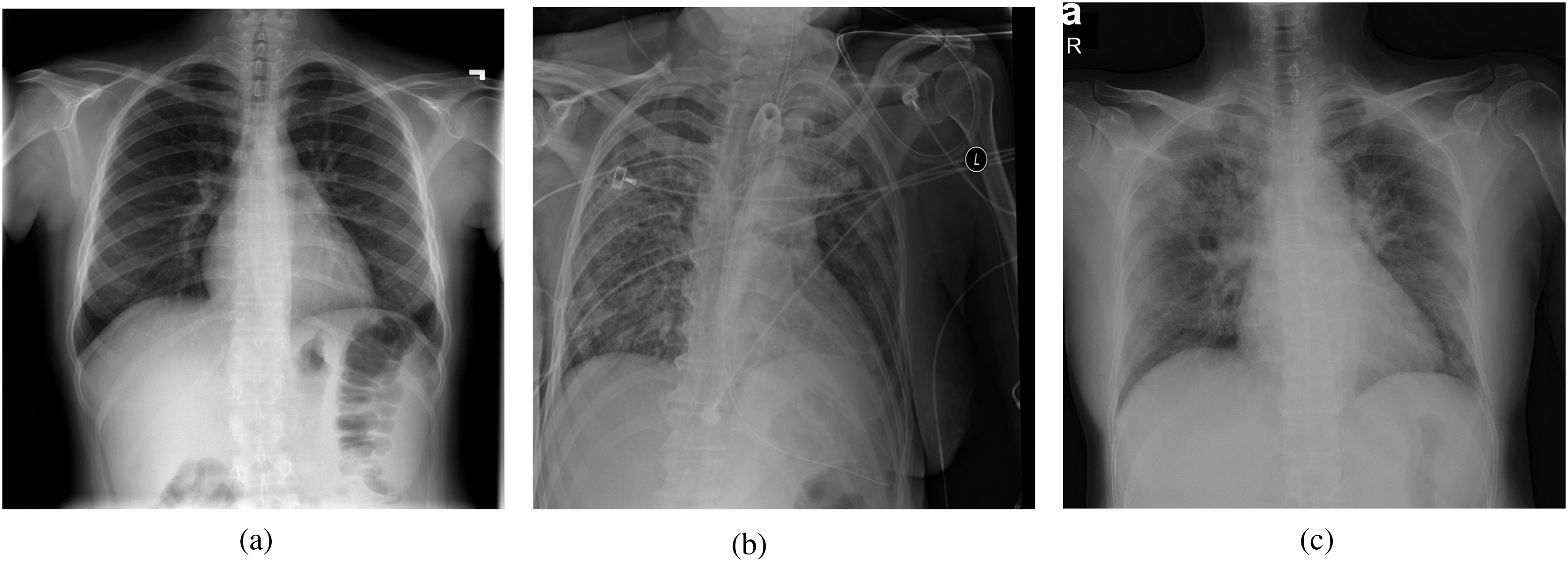
CXR images for normal and illness people from COVIDx datasets [2], which categorizes CXR images into classes of: (a) Normal case, (b) pneumonia case, and (c) COVID-19 case.
III. Related Work
To reduce the burden of detection from radiography images (e.g., CT and CXR images) for radiologists, there have been several AI-aided detection systems proposed, which are based on deep learning [20], [31], [37]. Due to several benefits of CXR imaging including portability, availability, accessibility and fast checking compared to CT imaging, CXR images are becoming a popular and commonly utilized data source for COVID-19 case detection.
Chowdhury et al. [11] made a model training comparison of different deep learning networks including AlexNet, ResNet18, DenseNet201, and SqueezeNet to classify two classes (i.e., COVID-19 and Normal) for CXR images, concluding that SqueezeNet outperforms other neural networks. Instead, Narin et al. [26] made a comparison of different CNN models (e.g., ResNet-50, Inception V3, and Inception-ResNetV2) trained on CXR images for COVID-19 case detection, showing that ResNet-50 outperforms the other two models with 98% accuracy. Farooq et al. [14] provided a COVID-ResNet by fine tuning a pretrained ResNet-50 architecture with a reported accuracy of 96.23%. Wang et al. [36] made a tailored and first open-sourced deep neural network called COVID-Net for COVID-19 case detection with CXR images. Tulin et al. [27] trained a deep learning scheme named DarkCovidNet, which detects COVID-19 cases based on a number of only 125 CXR images. Maghdid et al. [24] built deep learning models with pretrained AlexNet based on its own established dataset of X-ray images and CT images for COVID-19 case detection. Alom et al. [6] proposed a multitask deep learning system called COVID_MTNet for case detection by considering both CXR and CT images together. HSMA_WOA [4] hybrids the novel Slime mould algorithm together with whale optimization algorithm to address the CXR based image segmentation issue for detecting COVID-19 cases. In contrast, we focus on the COVID-19 case detection and HSMA_WOA is complementary to our article.
While these studies seem to offer pretty good results, the reliability of their proposed deep learning models can be questioned due to a serious bias problem for the COVID-19 dataset collected from a small sized group of COVID-19 cases [33]. Moreover, since the training processes of deep learning models rely on stochastic algorithms, they are sensitive to the specifies of training data and can produce different weights each time they are trained. Hence, the prediction result of a single deep learning model is prone to suffer from high variance and generalization errors due to the noise and a limited amount of COVID-19 datasets collected by far. Fortunately, these issues can be alleviated with the adoption of the ensemble learning technique. An ensemble deep learning model called EDL-COVID is proposed in this article by combining multiple snapshot deep learning models trained from state-of-the-art neural network of COVID-Net with a proposed WAE approach (see Section IV-B) that is aware of different sensitivities for different models on each class type.
IV. EDL-COVID: Ensemble Deep Learning Model for COVID-19 Case Detection
In this section, we introduce EDL-COVID, a snapshot ensemble deep learning model based on COVID-Net. As illustrated in Fig. 3, the overall training flow for EDL-COVID consists of two phases, namely, snapshot model training and model ensembling. The snapshot model training phase is responsible for producing multiple model snapshots (Section IV-A), which are then combined together for a final prediction in the model ensembling phase (Section IV-B). The detailed implementation of EDL-COVID can be found in Appendix A.
Fig. 3.

Overall flow for EDL-COVID ensemble model training. It consists of two phases, namely, snapshot model training, and model ensembling. We propose the WAE approach for model ensembling as described in Algorithm 1.
A. Snapshot Model Training
To enable deep learning ensembling, there is a need to have multiple pretrained deep learning models. However, the model training process generally takes hours and a large amount of computing resources, making deep learning ensembling become a time-consuming and heavy computation process. To alleviate it, we can instead train multiple model snapshots of a deep learning network for ensembling during a single training run, rather than training multiple models from different deep learning networks separately. In this article, we choose COVID-Net as the candidate to generate multiple model snapshots in terms of its promising performance for its CXR image based COVID-19 case detection, as well as public accessibility for its source code.
To make model ensembling effective in practice, there is a diversity requirement for multiple deep learning models that have different distributions of prediction errors. However, a limitation of such a model snapshot approach of a single deep learning network training is that the generated model snapshots tend to be similar, which can produce similar predictions and prediction errors. To address it, a commonly used approach is to take an aggressive learning rate schedule during a single training run that makes large changes of model weights and in turn the nature of model snapshots [22].
We take the cosine annealing learning rate schedule proposed by Loshchilov et al. [22] to change the learning rate aggressively but systematically to generate different model weights over training epochs, by allowing the learning rate to start high and decrease to a minimum value near zero at a relatively rapid speed before being increased again to the maximum based on the following formula
 |
where  is the maximum learning rate,
is the maximum learning rate,  is the learning rate at epoch
is the learning rate at epoch  and,
and,  denotes the number of cycles, and
denotes the number of cycles, and  is the overall number of epochs. Then each time a new model snapshot is produced after training a network for
is the overall number of epochs. Then each time a new model snapshot is produced after training a network for  cycles. Specifically, we train multiple model snapshots by initializing
cycles. Specifically, we train multiple model snapshots by initializing  , and
, and  for COVID-Net network with COVIDx dataset. Then 6 model snapshots would be produced from the COVID-Net network. Fig. 4 shows the aggressive variations of learning rates and corresponding training losses with the cosine annealing learning rate schedule during the model training process. We can see that such a significant variation of learning rate can produce different model weights by observing the big changes of intermediate training losses.
for COVID-Net network with COVIDx dataset. Then 6 model snapshots would be produced from the COVID-Net network. Fig. 4 shows the aggressive variations of learning rates and corresponding training losses with the cosine annealing learning rate schedule during the model training process. We can see that such a significant variation of learning rate can produce different model weights by observing the big changes of intermediate training losses.
Fig. 4.
Variations of learning rates and corresponding learning losses under cosine annealing learning rate schedule over training epochs. The aggressive change of learning rate produces different model weights with significantly different training loss, making a set of diverse models.
B. Model Ensembling
After generating multiple model snapshots in the first phase, we now come to the model ensembling phase for building EDL-COVID by combining these models as illustrated in Fig. 3. As we discussed in Section II-A, there are many ensembling strategies for model ensemble. For snapshot ensemble learning, averaging is a popular ensembling strategy [17]. For an input sample, it simply averages the class probabilities for each class from all models, respectively. Let  be the number of classifiers (i.e., deep learning models). Let
be the number of classifiers (i.e., deep learning models). Let  be the class probability of the
be the class probability of the  class output by the
class output by the  classifier with respect to the input sample
classifier with respect to the input sample  . Then the average class probability is
. Then the average class probability is  , for
, for  of the input sample
of the input sample  , with
, with  denoting the number of classes.
denoting the number of classes.
The traditional averaging ensembling strategy is implicitly based on the assumption that all models have the same weights. However, there are two key observations as follows.
-
1)
For a deep learning model, the testing accuracies for different classes are generally different.
-
2)
Different deep learning models tend to have different accuracies for each class. It indicates that we cannot simply treat each model equally during the model ensembling.
Based on the two observations above, we instead propose a WAE approach for snapshot model ensemble as depicted in Algorithm 1. Let  be the test accuracy of the
be the test accuracy of the  model for the
model for the  class over the test data of the CXR images dataset. Let
class over the test data of the CXR images dataset. Let  denote the normalized weight of the
denote the normalized weight of the  model for the
model for the  class. Then we have
class. Then we have  (Line 7). For each input sample
(Line 7). For each input sample  , we first get the output of every class probability
, we first get the output of every class probability  from the
from the  model for
model for  (Line 10–12). Then we can estimate the class probability
(Line 10–12). Then we can estimate the class probability  of EDL-COVID by summing up the weighted class probabilities of all models (Line 13–14) for
of EDL-COVID by summing up the weighted class probabilities of all models (Line 13–14) for  . Finally, we can get the predicted class by returning the class index with the maximum class probability for each input sample (Line 15).
. Finally, we can get the predicted class by returning the class index with the maximum class probability for each input sample (Line 15).
Algorithm 1: Pseudo Code of the Proposed WAE Approach.
-
1:
Input:
-
2:
 the number of classifiers (i.e., deep learning models).
the number of classifiers (i.e., deep learning models). -
3:
 the size of CXR images dataset.
the size of CXR images dataset. -
4:
 the number of classes for CXR images dataset.
the number of classes for CXR images dataset. -
5:
 the test accuracy of the
the test accuracy of the  model for the
model for the  class.
class. -
6:
 the
the  input sample of CXR images dataset.
input sample of CXR images dataset. -
7:
 the normalized weight of the
the normalized weight of the  model for WAE over the
model for WAE over the  class prediction, where
class prediction, where  .
. -
8:
Output:
-
9:
 the predicted class index for the
the predicted class index for the  input sample with EDL-COVID.
input sample with EDL-COVID. -
10:
for
 to
to
 do
do -
11:
for
 to
to
 do
do -
12:
Get the output (i.e., class probability vector
 for all
for all  classes where
classes where  ) of the
) of the  model w.r.t. the input sample
model w.r.t. the input sample  .
. -
13:
end for
-
14:
for
 to
to
 do
do -
15:
 .
. -
16:
end for
-
17:

-
18:
Get the class index with the maximum class probability for the
 input sample.
input sample. -
19:
end for
V. Experimental Evaluation
We have implemented EDL-COVID atop of TensorFlow based on COVID-Net, and evaluated EDL-COVID using CXR images of the COVIDx dataset in a GPU machine.
A. Experimental Setup
GPU Machine. We train and evaluate our proposed model on a GPU machine consisting of two Intel Xeon E5-2640 CPUs, 256 GB of RAM, and two NVIDIA Tesla P100 GPUs. It runs on CentOS 7.7 OS with TensorFlow 2.0.0 installed for deep learning model training and inference, where cuDNN is enabled to speedup the training computation on a GPU device.
Dataset. We take the latest COVIDx dataset proposed by Wang et al. [2] for model training and evaluation in our experiment. It totally contains 15477 CXR images from 13870 cases by  June 2020, comprising of 6053 Pneumonia, 8851 Normal, and 573 COVID-19 cases images. The COVIDx dataset is collected from five different data sources, namely, ActualMed COVID-19 dataset,2 COVID-19 image data collection,3 COVID-19 radiography database,4 COVID-19 CXR dataset initiative,5 as well as RSNA pneumonia detection challenge.6 In our experiment below, we take 13898 CXR images from the COVIDx dataset for model training and the remaining 1579 CXR images for testing. Specifically, for training data, it consists of 7966 Normal, 5459 Pneumonia, and 473 COVID-19 CXR images. In contrast, there are 885 normal, 594 pneumonia, and 100 COVID-19 CXR images for testing data.
June 2020, comprising of 6053 Pneumonia, 8851 Normal, and 573 COVID-19 cases images. The COVIDx dataset is collected from five different data sources, namely, ActualMed COVID-19 dataset,2 COVID-19 image data collection,3 COVID-19 radiography database,4 COVID-19 CXR dataset initiative,5 as well as RSNA pneumonia detection challenge.6 In our experiment below, we take 13898 CXR images from the COVIDx dataset for model training and the remaining 1579 CXR images for testing. Specifically, for training data, it consists of 7966 Normal, 5459 Pneumonia, and 473 COVID-19 CXR images. In contrast, there are 885 normal, 594 pneumonia, and 100 COVID-19 CXR images for testing data.
B. Performance Evaluation for Individual Model
Performance metrics of each individual model are evaluated in the following aspects.
Accuracy Evaluation. We have trained six deep learning models (denoted as COVID-Net-M1, COVID-Net-M2,  , COVID-Net-M6) with COVID-Net network architecture on top of COVIDx dataset. Fig. 5 presents the prediction accuracy for all models. It shows that the ensembling approach of our proposed EDL-COVID model can make it effectively outperform the other six deep learning models by about 0.3%.
, COVID-Net-M6) with COVID-Net network architecture on top of COVIDx dataset. Fig. 5 presents the prediction accuracy for all models. It shows that the ensembling approach of our proposed EDL-COVID model can make it effectively outperform the other six deep learning models by about 0.3%.
Fig. 5.
Overall prediction accuracy.
However, in practice, we cannot simply make a judgment that a model with a higher accuracy must work better than a model with a lower accuracy for a multiclass problem. We need to further take a look at the other two important class-level metrics, namely, sensitivity and positive predictive value (PPV) as well.
Sensitivity Evaluation. In medical analysis, the sensitivity of a disease can be interpreted as the proportion of people with a certain disease that has been successfully identified. Taking COVID-19 for example, achieving a high sensitivity is quite important since we do not want to omit any affected people during our COVID-19 testing, otherwise the affected people that have been omitted cannot receive immediate treatment, and meanwhile, they can affect other people. Table I gives a sensitivity analysis for each model with respect to each class type. We have the following observations. It is seldom to have a model that works best for all three classes. For example, COVID-Net-M5 has the highest sensitivity in Normal class but not for two other class types. In comparison, EDL-COVID has the highest sensitivities for both Pneumonia and COVID-19 classes although its sensitivity of Normal class is not the best across all models. From a practical point of view, there is no doubt to consider EDL-COVID since a high sensitive screening for infectious diseases such as COVID-19 is very important.
TABLE I. Sensitivities of Different Models on Each Class (E.g., Normal, Pneumonia, and COVID-19), Where the Best Results are Highlighted in Bold.
| Sensitivity (%) | |||
|---|---|---|---|
| Model | Normal | Pneumonia | COVID-19 |
| COVID-Net-M1 | 93.2 | 94.8 | 91.0 |
| COVID-Net-M2 | 93.4 | 95.1 | 91.0 |
| COVID-Net-M3 | 94.1 | 90.2 | 95.0 |
| COVID-Net-M4 | 94.8 | 94.8 | 94.0 |
| COVID-Net-M5 |

|
93.6 | 92.0 |
| COVID-Net-M6 | 95.3 | 90.2 | 96.0 |
| EDL-COVID | 95.0 |

|

|
PPV Evaluation. PPV denotes the probability of positive results that are true positive results in diagnostic tests according to (4). If this value is small, it means that there are many false positives and a follow-up testing is needed for any positive result with a more reliable result. For COVID-19 screening, if a model's PPV is small, we cannot make a judgment that a person with a positive testing result is the true COVID-19 case and more accurate testing is needed for positive testing results. Table II gives a PPV analysis for each model on each class type. Still, no model performs the best for all class types. COVID-Net-M6 has the highest PPV on pneumonia class, and our EDL-COVID achieves the highest PPVs for Normal and COVID-19 classes.
TABLE II. PPV of Different Models on Each Class (E.g., Normal, Pneumonia, and COVID-19), Where the Best Results are Highlighted in Bold.
| Positive Predictive Value (%) | |||
|---|---|---|---|
| Model | Normal | Pneumonia | COVID-19 |
| COVID-Net-M1 | 96.3 | 89.9 | 94.0 |
| COVID-Net-M2 | 96.2 | 90.5 | 92.9 |
| COVID-Net-M3 | 95.2 | 92.7 | 75.4 |
| COVID-Net-M4 | 96.3 | 92.8 | 93.1 |
| COVID-Net-M5 | 95.7 | 93.6 | 92.9 |
| COVID-Net-M6 | 94.8 |

|
78.7 |
| EDL-COVID |

|
93.1 |

|
In summary, we can conclude that, although no model outperforms others on all metrics for all classes types, for COVID-19 case detection, our proposed EDL-COVID is the best choice since it outperforms other models on the accuracy, sensitivity, and PPV for COVID-19 class type.
C. EDL-COVID Evaluation Results
In this section, we evaluate the EDL-COVID model from the following perspectives.
Weights Estimation for WAE. Recall in Section IV-B that we proposed a model ensembling strategy called WAE to combine multiple deep learning models with the awareness of different accuracies on different class types for different models. We first need to obtain weights for all deep learning models on each class type for WAE. Fig. 6 illustrates the estimated class-level weights for all deep learning models, which is based on the estimated sensitivity result on each class type as shown in Table I. We can see that different classes tend to have different weights for different deep learning models. For example, for COVID-Net-M6, it has the largest weight for the COVID-19 class but relatively low weight for the Pneumonia class.
Fig. 6.
Estimated class-level weights for six deep learning models needed by WAE in model ensembling.
Predicted Results. The confusion matrix for the proposed EDL-COVID is presented as in Fig. 7, which analyzes the COVIDx dataset, including CXR images of 100 COVID-19 cases, 594 pneumonia cases, and 885 normal cases. For COVID-19 testing, only four out of 100 CXR images of COVID-19 are not screened out, and six out of 1579 CXR images are mistakenly considered as COVID-19, indicating that the error ratio is minor compared to the total number of CXR images for EDL-COVID.
Fig. 7.
Confusion matrix for EDL-COVID on COVIDx dataset that consists of 100 COVID-19, 594 pneumonia, and 885 normal images. The red box is the true prediction, and the light blue box is the false prediction.
To show the detection capability of EDL-COVID, we draw ROC curves for EDL-COVID prediction on COVIDx test dataset with respect to each class type in Fig. 8. Larger area of ROC area is an indication of better prediction ability. We can see that the ROC area for each class under EDL-COVID is much closer to the maximum value of one, indicating that our proposed EDL-COVID has a good prediction capability for each class type in practice.
Fig. 8.
ROC curves of EDL-COVID prediction on COVIDx test dataset with respect to each class type.
Model Execution Time Evaluation. Fig. 9 illustrates the execution time for EDL-COVID to handle different numbers of testing CXR images. We can see that a linear relationship is demonstrated between the data size and the total execution time, indicating that our proposed EDL-COVID is scalable. Moreover, we also present the average execution time for processing a CXR image. Interestingly, the average execution time drops significantly we increase the number of CXR images at the beginning and later becomes smooth when the total number of images is larger than 1000. This is because EDL-COVID takes time to load the six models during its computing process (i.e., overhead), which cannot be ignored when the workload size is small. However, it becomes relatively small for such an overhead when the workload size becomes large, making the average execution time per image becomes smaller first and later keep stable as observed.
Fig. 9.
Execution time for EDL-COVID under different numbers of testing CXR images.
VI. Conclusion
In this article, to overcome several problems of overfitting, high variance, and generalization errors of an individual deep learning model for improved performance on COVID-19 case detection, we proposed EDL-COVID, an ensemble deep learning model called for COVID-19 case detection from CXR images on the basis of the open-sourced network architecture called COVID-Net. We first generated multiple model snapshots by training the COVID-Net network on top of COVIDx CXR datasets, followed by ensembling these models with a proposed WAE ensembling approach that is aware of different sensitivities for different deep learning models on different classes types. Experiments on a COVIDx test data of 1579 CXR images show that EDL-COVID can detect COVID-19 cases with good promising results of 96% sensitivity and 94.1% PPVs, outperforming each individual deep learning model. We hope our AI-based screening approach can aid radiologists to accelerate the screening of COVID-19 cases while guaranteeing a high accuracy in the current COVID-19 pandemic around the world.
Yet, current work is heavily dependent on work by Wang et al. [36] on COVID-Net network architecture and COVIDx dataset. There are several future work that can be done to enhance EDL-COVID for practical use. First, the number of COVID-19 CXR images is still relatively small compared to CXR images of other classes for the COVIDx dataset, indicating that we cannot simply make a judgment that the currently trained model snapshots from COVID-Net architecture continue to work well with a high accuracy for unseen COVID-19 CXR images. To improve EDL-COVID, we need to retrain model snapshots of COVID-Net whenever new CXR images are available. Besides snapshot models, we can also incorporate some other publicly available good deep learning models into EDL-COVID for better performance. Second, we would plan to extend EDL-COVID for other COVID-19 applications such as risk stratification for COVID-19 cases survival analysis, risk status analysis of COVID-19 cases, which are important for patient hospitalization and care planning.
Biographies

Shanjiang Tang received the B.S. degree in software engineering and the M.S. degree in computer science and technology from Tianjin University (TJU), China, in 2008 and 2011, respectively, and the Ph.D. degree in computer engineering from the School of Computer Engineering, Nanyang Technological University, Singapore, in 2015.
He is currently an Associate Professor with the College of Intelligence and Computing, TJU. He has authored or coauthored many papers in IEEE Transactions on Cloud Computing, IEEE Transactions on Parallel and Distributed Systems, IEEE Transactions on Knowledge and Data Engineering, IEEE Transactions on Services Computing, ACM/IEEE Supercomputing Conference, International Conference on Supercomputing, IEEE International Symposium on High Performance Distributed Computing, etc. His research interests include parallel computing, cloud computing, big data analysis, and machine learning.

Chunjiang Wang received the B.S. degree in network engineering from the School of Computer Science and Technology, Tiangong University, Tianjin, China, in 2019. He is currently working toward the M.S. degree in computer science and technology with the College of Intelligence and Computing, Tianjin University (TJU), China.
His research interests include deep learning, video analysis, cloud computing, and parallel computing.

Jiangtian Nie received the B.S. degree in electronic and information engineering from the Huazhong University of Science and Technology, Wuhan, China, in 2016. She is currently working toward the Ph.D. degree with ERI@N, Interdisciplinary Graduate School, Nanyang Technological University, Singapore.
Her research interests include incentive mechanism design in crowdsensing and game theory.

Neeraj Kumar is currently a Professor with the Department of Computer Science and Engineering, Thapar Institute of Engineering and Technology, Patiala, India. He has authored or coauthored more than 400 technical research papers in top-cited journals and conferences which are cited more than 15 000 times from well-known researchers across the globe with current h-index of 68 in Google scholar. His research areas are green computing and network management, IoT, big data analytics, deep learning, and cyber-security.
Prof. Kumar is currently the Editor for ACM Computing Survey, IEEE Transactions on Sustainable Computing, IEEE Systems Journal, IEEE Network Magazine, IEEE Communication Magazine, Elsevier Journal of Networks and Computer Applications, Elsevier Computer Communication, and Wiley International Journal of Communication Systems. He is also the TPC Chair and member for various International conferences such as IEEE MASS 2020, IEEE MSN2020. He was the recipient of the Best Papers Award from IEEE Systems Journal and IEEE ICC 2018, Kansas-city in 2018. He was also the recipient of the Best Researcher award from parent organization every year from last eight consecutive years.

Yang Zhang received the B.Eng. degree in aeronautics science and engineering, B.Eng. (Minor) degree in applied mathematics, and M.Eng. degree in computer science and technology from the Beijing University of Aeronautics and Astronautics (Beihang Univ.), Beijing, China, in 2008, 2010, and 2011, respectively, and the Ph.D. degree in computer engineering from Nanyang Technological University, Singapore, in 2015.
He is currently an Associate Professor with the Wuhan University of Technology, China.
Dr. Zhang is currently an Associate Editor for the EURASIP Journal on Wireless Communications and Networking, and a Technical Committee Member of Computer Communications.

Zehui Xiong received the B.S. degree in electronic and information engineering and the Ph.D. degree in computer science and technology from Nanyang Technological University, Singapore.
He is currently an Assistant Professor with the Pillar of Information Systems Technology and Design, Singapore University of Technology and Design, Singapore. He has authored or coauthored more than 90 research papers in leading journals and flagship conferences and four of them are ESI Highly Cited Papers. His research interests include wireless communications, network games and economics, blockchain, and edge intelligence.
Dr. Xiong was the recipient of five Best Paper Awards in international conferences and technical committees, and the Chinese Government Award for Outstanding Students Abroad in 2019, and the NTU SCSE Best Ph.D. Thesis Runner-Up Award in 2020. He is currently the Editor or Guest Editor for many leading journals including the IEEE Transactions.

Ahmed Barnawi received the M.Sc. degree from UMIST, U.K., in 2001, and the Ph.D. degree from the University of Bradford, U.K., in 2005.
He is currently a Professor with the Faculty of Computing and IT with King Abdulaziz University, Jeddah, Saudi Arabia. He is the Managing Director of the KAU Cloud computing and Big Data Research Group. His research interests include big data, cloud computing, and advanced mobile robotic applications. He has authored or coauthored more than 100 papers in peer-reviewed journals.
Appendix A. The Implementation of EDL-COVID
As discussed in Section IV, EDL-COVID consists of two parts, i.e., snapshot model training and model ensembling. In this section, we present its key implementation codes for the sake of a better understanding of EDL-COVID.
Fig. 10 shows the snapshot model training codes for EDL-COVID. To output a set of diverse snapshot models, we leverage cosine annealing learning rate schedule to dynamically estimate and adjust learning rate aggressively and systematically (Line 26), which is implemented in CosineAnnealingLearningRateSchedule()(Line 2–22). Next, we load the training and testing data (Line 27–46). After that, we start to train models with provided COVID-Net network architecture (Line 47–101). Typically, at the beginning of each epoch, we adjust the learning rate dynamically (Line 78). We spill the intermediate snapshot model into disks at every epochs_per_cycle configured by users (Line 99–101).
Fig. 10.
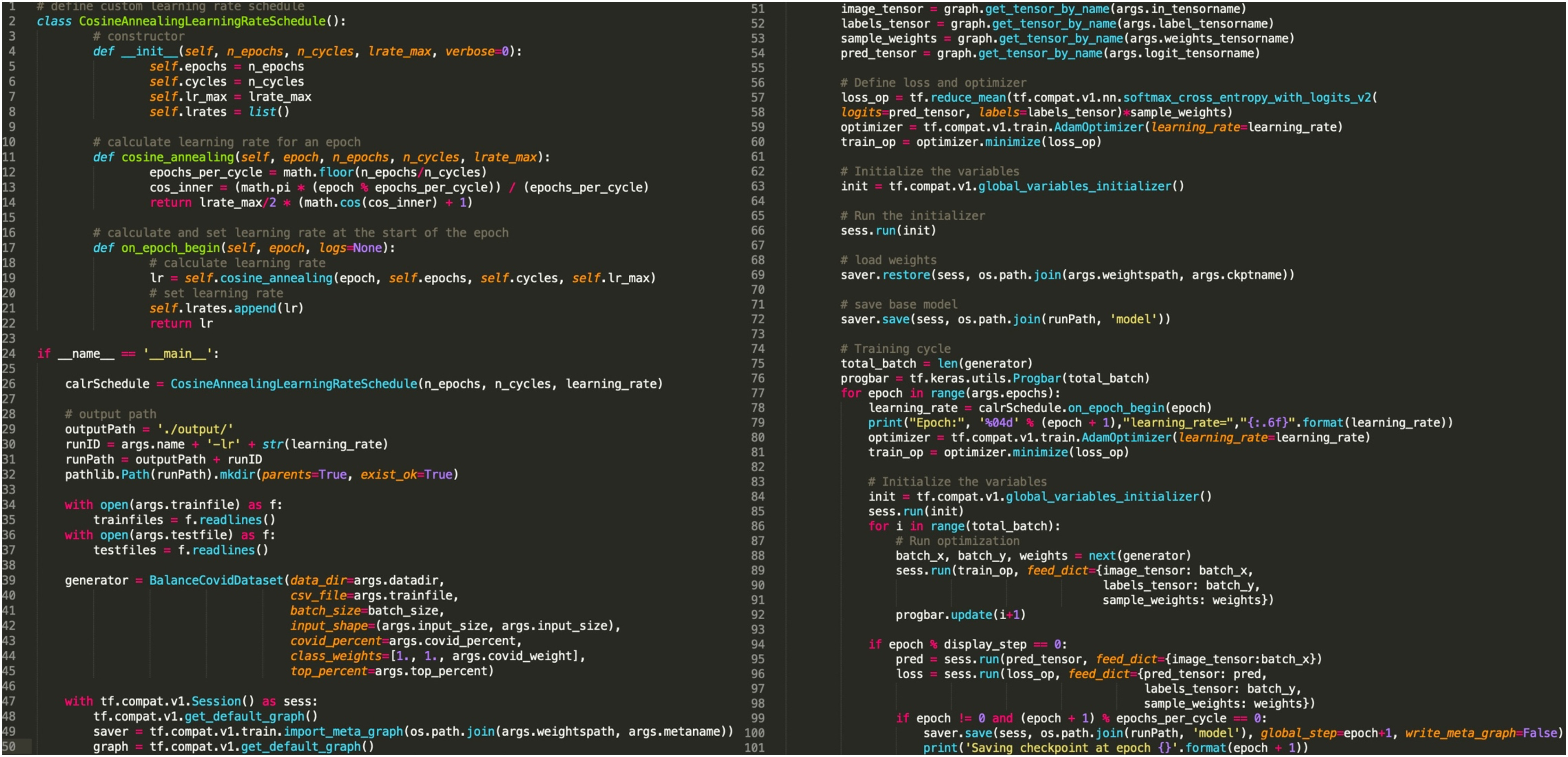
Core source codes of snapshot models training for EDL-COVID.
Fig. 11 presents the model ensemble implementation for EDL-COVID. We first use test data to estimate the class-level accuracy for each snapshot model trained at the previous stage with a prediction_accuracy function (Line 2–14), whose implementation is given in Line 21–52. With the class-level accuracies of snapshot models on each class, we next move to estimate the class-level weights for each model (Line 16–18) with class_weight_estimate function, whose implementation is given in Line 53–70. Finally, we perform a model ensemble for all snapshot models with WAE strategy (Line 19–22) via wae_estimate function, which are detailed in Line 71–103.
Fig. 11.
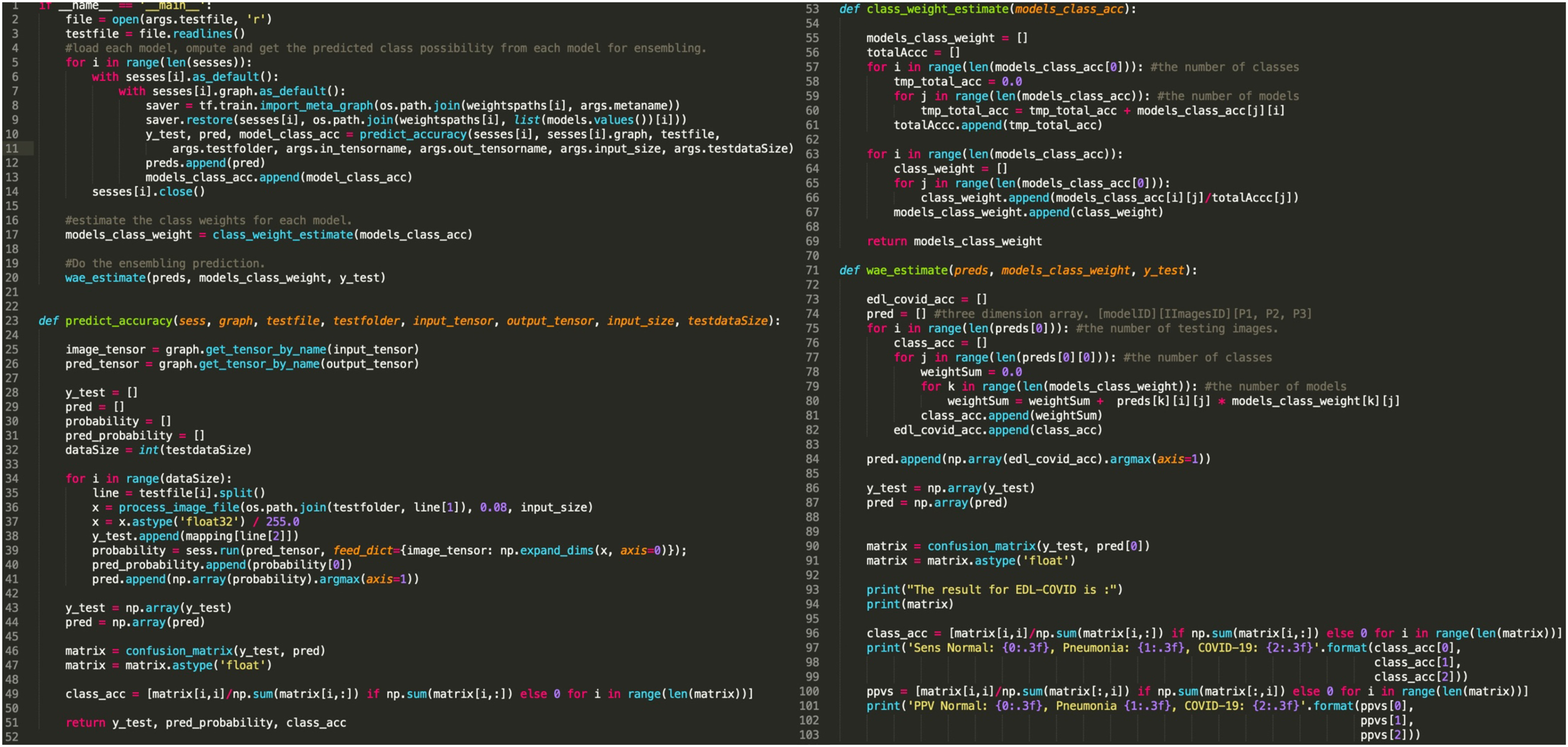
Core source codes of snapshot models ensembling for EDL-COVID.
Funding Statement
This work was supported in part by the National the Natural Science Foundation of China under Grant 61972277, in part by Tianjin Natural Science Foundation under Grant 18JCZDJC30800, in part by National Natural Science Foundation of China under Grant 62071343 and Grant 51609195, and in part by the Open Research Project of the State Key Laboratory of Industrial Control Technology, Zhejiang University, China under Grant ICT20044.
Footnotes
[Online]. Available: https://github.com/lindawangg/COVID-Net.
[Online]. Available: https://github.com/agchung/Actualmed-COVID-chestxray-dataset.
[Online]. Available: https://github.com/ieee8023/covid-chestxray-dataset.
[Online]. Available: https://kaggle.com/tawsifurrahman/covid19-radiography-database.
[Online]. Available: https://github.com/agchung/Figure1-COVID-chestxray-dataset.
[Online]. Available: https://kaggle.com/c/rsna-pneumonia-detection-challenge.
Contributor Information
Shanjiang Tang, Email: tashj@tju.edu.cn.
Chunjiang Wang, Email: tju_wcj@tju.edu.cn.
Jiangtian Nie, Email: jnie001@e.ntu.edu.sg.
Neeraj Kumar, Email: neeraj.kumar@thapar.edu.
Yang Zhang, Email: yangzhang@whut.edu.cn.
Zehui Xiong, Email: zehui_xiong@sutd.edu.sg.
Ahmed Barnawi, Email: ambarnawi@kau.edu.sa.
References
- [1].Coronavirus Disease 2019. 2020. [Online]. Available: https://en.wikipedia.org/wiki/Coronavirus_disease_2019
- [2].Covidx Dataset. 2020. [Online]. Available: https://github.com/lindawangg/COVID-Net/blob/master/docs/COVIDx.md
- [3].Abdel-Basset M., Chang V., Hawash H., Chakrabortty R. K., and Ryan M., “FSS-2019-nCov: A deep learning architecture for semi-supervised few-shot segmentation of covid-19 infection,” Knowl.-Based Syst. vol. 212, 2021, Art. no. 106647. [DOI] [PMC free article] [PubMed] [Google Scholar]
- [4].Abdel-Basset M., Chang V., and Mohamed R., “HSMA_WOA: A hybrid novel slime mould algorithm with whale optimization algorithm for tackling the image segmentation problem of chest x-ray images,” Appl. Soft Comput., vol. 95, 2020, Art. no. 106642. [DOI] [PMC free article] [PubMed] [Google Scholar]
- [5].Albawi S., Mohammed T. A., and Al-Zawi S., “Understanding of a convolutional neural network,” in Proc. Int. Conf. Eng. Technol., 2017,. pp. 1–6. [Google Scholar]
- [6].Alom M. Z., Rahman M., Nasrin M. S., Taha T. M., and Asari V. K., COVID_MTNet: Covid-19 detection with multi-task deep learning approaches, 2020, arXiv:2004.03747.
- [7].Borghesi A. and Maroldi R., “COVID-19 outbreak in italy: Experimental chest x-ray scoring system for quantifying and monitoring disease progression,” La Radiologia Med., vol. 125, no. 5, pp. 509–513, 2020. [DOI] [PMC free article] [PubMed] [Google Scholar]
- [8].Cao Z., Liao T., Song W., Chen Z., and Li C., “Detecting the shuttlecock for a badminton robot: A yolo based approach,” Expert Syst. Appl., vol. 164, 2020, Art. no. 113833. [Google Scholar]
- [9].Chen S., Dobriban E., and Lee J. H., “Invariance reduces variance: Understanding data augmentation in deep learning and beyond,” 2019, arXiv:1907.10905.
- [10].Cheng Y.-Y., Chan P. P., and Qiu Z.-W., “Random forest based ensemble system for short term load forecasting,” in Proc. Int. Conf. Mach. Learn. Cybernet., 2012, pp. 52–56. [Google Scholar]
- [11].Chowdhury M. E. et al. , “Can AI help in screening Viral and COVID-19 pneumonia?,” 2020, arXiv:2003.13145. [Google Scholar]
- [12].Divina F., Gilson A., Goméz-Vela F., Torres M. García, and Torres J. F., “Stacking ensemble learning for short-term electricity consumption forecasting,” Energies, vol. 11, no. 4, 2018, Art. no. 949. [Google Scholar]
- [13].Faria F. A., Dos Santos J. A., Rocha A., and Torres R. d. S., “A framework for selection and fusion of pattern classifiers in multimedia recognition,” Pattern Recognit. Lett., vol. 39, pp. 52–64, 2014. [Google Scholar]
- [14].Farooq M. and Hafeez A., “COVID-ResNet: A deep learning framework for screening of COVID19 from radiographs,” 2020, arXiv:2003.14395.
- [15].Guan W.-J. et al. , “Clinical characteristics of coronavirus disease 2019 in China,” New England J. Med., vol. 382, no. 18, pp. 1708–1720, 2020. [DOI] [PMC free article] [PubMed] [Google Scholar]
- [16].Huang C. et al. , “Clinical features of patients infected with 2019 novel coronavirus in Wuhan, China,” Lancet, vol. 395, no. 10223, pp. 497–506, 2020. [DOI] [PMC free article] [PubMed] [Google Scholar]
- [17].Huang G., Li Y., Pleiss G., Liu Z., Hopcroft J. E., and Weinberger K. Q., “Snapshot ensembles: Train 1, get M for free,” 2017, arXiv:1704.00109.
- [18].Jacobi A., Chung M., Bernheim A., and Eber C., “Portable chest x-ray in coronavirus disease-19 (COVID-19): A pictorial review,” Clin. Imag., vol. 64, pp. 35–42, 2020. [DOI] [PMC free article] [PubMed] [Google Scholar]
- [19].Jakubovitz D., Giryes R., and Rodrigues M. R., “Generalization error in deep learning,” in Compressed Sensing and Its Applications, Springer, 2019, pp. 153–193. [Google Scholar]
- [20].Kumar A., Gupta P. K., and Srivastava A., “A review of modern technologies for tackling COVID-19 pandemic,” Diabetes Metabolic Syndrome Clin. Res. Rev., vol. 14, no. 4, pp. 569–573, 2020. [DOI] [PMC free article] [PubMed] [Google Scholar]
- [21].Lakhani P. and Sundaram B., “Deep learning at chest radiography: Automated classification of pulmonary tuberculosis by using convolutional neural networks,” Radiology, vol. 284, no. 2, pp. 574–582, 2017. [DOI] [PubMed] [Google Scholar]
- [22].Loshchilov I. and Hutter F., “SGDR: Stochastic gradient descent with warm restarts,” 2016, arXiv:1608.03983.
- [23].Ma C., Liu Z., Cao Z., Song W., Zhang J., and Zeng W., “Cost-sensitive deep forest for price prediction,” Pattern Recognit., vol. 107, 2020, Art. no. 107499. [Google Scholar]
- [24].Maghdid H. S., Asaad A. T., Ghafoor K. Z., Sadiq A. S., and Khan M. K., “Diagnosing COVID-19 pneumonia from x-ray and CT images using deep learning and transfer learning algorithms,” 2020, arXiv:2004.00038.
- [25].Nair A. et al. , “A British Society of Thoracic Imaging statement: Considerations in designing local imaging diagnostic algorithms for the COVID-19 pandemic,” Clin. Radiol., vol. 75, no. 5, pp. 329–334, 2020. [DOI] [PMC free article] [PubMed] [Google Scholar]
- [26].Narin A., Kaya C., and Pamuk Z., “Automatic detection of coronavirus disease (COVID-19) using x-ray images and deep convolutional neural networks,” 2020, arXiv:2003.10849. [DOI] [PMC free article] [PubMed]
- [27].Ozturk T., Talo M., Yildirim E. A., Baloglu U. B., Yildirim O., and Acharya U. R., “Automated detection of COVID-19 cases using deep neural networks with x-ray images,” Comput. Biol. Med., vol. 121, 2020, Art. no. 103792. [DOI] [PMC free article] [PubMed] [Google Scholar]
- [28].Polikar R., “Ensemble learning,” in Ensemble Machine Learning, Boston, MA: Springer, 2012, pp. 1–34. [Google Scholar]
- [29].Rajaraman S., Siegelman J., Alderson P. O., Folio L. S., Folio L. R., and Antani S. K., “Iteratively pruned deep learning ensembles for COVID-19 detection in chest x-rays,” 2020, arXiv:2004.08379. [DOI] [PMC free article] [PubMed]
- [30].Shen M. et al. , “Recent advances and perspectives of nucleic acid detection for coronavirus, J. Pharmaceut. Anal., vol. 10, no. 2, pp. 97–101, 2020. [DOI] [PMC free article] [PubMed] [Google Scholar]
- [31].Shi F. et al. , “Review of artificial intelligence techniques in imaging data acquisition, segmentation and diagnosis for COVID-19,” IEEE Rev. Biomed. Eng., vol. 14, pp. 4–15, 2021, doi: 10.1109/RBME.2020.2987975. [DOI] [PubMed] [Google Scholar]
- [32].Svetnik V., Wang T., Tong C., Liaw A., Sheridan R. P., and Song Q., “Boosting: An ensemble learning tool for compound classification and QSAR modeling, J. Chem. Inf. Model., vol. 45, no. 3, pp. 786–799, 2005. [DOI] [PubMed] [Google Scholar]
- [33].Tabik S. et al. “COVIDGR dataset and COVID-SDNet methodology for predicting COVID-19 based on chest x-ray images,” 2020, arXiv:2006.01409. [DOI] [PMC free article] [PubMed]
- [34].Tahamtan A. and Ardebili A., “Real-time RT-PCR in COVID-19 detection: Issues affecting the results,” Expert Rev. Mol. Diagn., vol. 10, no. 5, pp. 453–454, 2020. [DOI] [PMC free article] [PubMed] [Google Scholar]
- [35].Udugama B. et al. , “Diagnosing COVID-19: The disease and tools for detection,” ACS Nano, vol. 14, no. 4,pp. 3822–3835, 2020. [DOI] [PubMed] [Google Scholar]
- [36].Wang L. and Wong A., “COVID-Net: A tailored deep convolutional neural network design for detection of COVID-19 cases from chest x-ray images,” 2020, arXiv:2003.09871. [DOI] [PMC free article] [PubMed]
- [37].Wynants L. et al. , “Prediction models for diagnosis and prognosis of COVID-19 infection: Systematic review and critical appraisal,” Brit. Med. J., vol. 369, 2020, Art. no. m1328. [DOI] [PMC free article] [PubMed] [Google Scholar]
- [38].Zhou S., Wang Y., Zhu T., and Xia L., “CT features of coronavirus disease 2019 (COVID-19) pneumonia in 62 patients in Wuhan, China,” Amer. J. Roentgenol., vol. 214, no. 6, pp. 1287–1294, 2020. [DOI] [PubMed] [Google Scholar]



